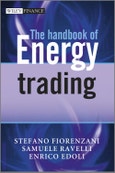The Handbook of Energy Trading covers in detail all these various aspects of energy trading. Throughout the book, the authors draw on their considerable professional experience, and provide up–to–the–minute examples and case studies from the energy sector. The Handbook:
- Offers a unique, integrated approach, combining clear and accessible coverage of academic theory with practical guidance on all aspects of energy trading, including operational strategies, quantitative methods and practical trading techniques
- Highlights and explains the most successful trading strategies and instruments and how they can and should be used
- Details how energy trading is different from other types of trading and shows how those differences can be used to gain advantage
- Sets out how to structure an energy trading enterprise in order to maximize profitability
This comprehensive and detailed approach makes The Handbook of Energy Trading the complete guide to achieving success in today s booming energy markets.
Table of Contents
List of Figures xiList of Tables xv
Preface xvii
Acknowledgements xix
1 Energy Markets as Efficient Markets 1
1.1 The Efficient Market Hypothesis 1
1.1.1 Trading Implications 2
1.1.2 Informational and Mathematical Implications 3
1.2 Mathematical Framework 3
1.2.1 Information Set: s–algebras 3
1.2.2 Conditional Expectation 5
1.3 Martingale Hypothesis 7
1.3.1 The Random Walk Hypothesis 8
1.3.2 Sequences and Reversal, Cowles Jones Test: Theoretical
Framework 10
1.3.3 Variance Ratio Tests 11
1.4 Violations of EMH and Behavioural Finance 13
1.5 Information Asymmetries and Accelerating Processes 15
1.6 The Peculiar Structure and Nature of Energy Commodities
Markets 17
1.7 EHM in Energy Commodities Markets: Some Evidence from Data 19
1.7.1 Efficient Market Hypothesis: Testing the Intraday Returns 26
1.8 Subordination, Trading Volume and Efficient Market Hypothesis 27
1.9 Subordination and Stochastic Timescales 28
2 Directional Trading 33
2.1 Definitions and Main Features 33
2.2 Market Products for Directional Trading 35
2.3 Price Trend Determination 37
2.3.1 Fundamental Trading Models 37
2.3.2 Statistical Trading Models 42
2.3.3 Technical Trading Models 49
2.3.4 Case Studies 51
2.4 Strategic Asset Allocation Methods 57
2.4.1 Traditional Asset Allocation Models 57
2.4.2 Single Period Asset Allocation Model 58
2.4.3 Inter–temporal Asset Allocation Problems 59
2.4.4 Solution Methods Dynamic Programming 62
2.4.5 Asset Allocation with Capital Constraints 76
3 Spread Trading 81
3.1 Spread Definition and Identification 82
3.2 Non–Stationarity and Cointegration 84
3.3 Empirical Analysis of Energy Spread Trading Strategies 89
3.4 Empirical Analysis of Energy Spreads and Spread Trading
Strategies 92
3.4.1 Cross Commodities Spread Trading (Spark Spread) 92
3.4.2 Time Spreads on Brent 95
3.4.3 Location Spread: Italy vs. Germany 96
3.5 Combining Directional and Spread Trading Strategies 98
4 Options and Non–Linear Derivatives 101
4.1 The Essence of Non–Linearity 101
4.1.1 Factors that Influence Option Value 103
4.1.2 Option Traders 104
4.1.3 Energy Option Markets 105
4.2 Exotic Options 105
4.3 Combinations 109
4.4 Value Bounds and Parity Relationship 112
4.5 Basics on Option Pricing 115
4.6 The Greeks 119
4.6.1 Delta and Delta Hedging 120
4.6.2 Gamma 120
4.6.3 Theta 121
4.6.4 Vega 121
4.7 Adjusting the Continuous Time Dynamic Hedging Framework 122
4.7.1 Discrete and Extreme Market Moves 122
4.7.2 Gamma and Shadow Gamma 123
4.7.3 Vega and Volatility Surface Movements 124
4.7.4 Theta, and Greek s Importance for Exotic Option Traders 125
4.7.5 Futures and Forwards to Hedge the Risk: Structured
Products 125
4.8 Case Study 126
5 Structured Products on Energy 131
5.1 Structured Products on Energy: Main Typology 131
5.2 Retail Structured Products 133
5.2.1 Profiled Forward Contracts 133
5.2.2 Full Requirements Contracts 134
5.3 Wholesale Structured Products 135
5.3.1 General Pricing Issues on Structured Products 135
5.3.2 Virtual Power Plants: Structure and Pricing Techniques 140
5.3.3 Virtual Refinery: Structure and Pricing Techniques 142
5.3.4 Virtual Gas Storage: Structure and Pricing Techniques 144
5.3.5 The Structure of Swing Contracts and Make–up Clause 146
5.4 Hedge in Incomplete Markets 149
5.5 Case Study: Structured Products 152
5.5.1 Virtual Power Plants 152
5.5.2 Swing on Gas 155
5.5.3 Virtual Refinery 158
6 Metatrading Strategies and Capital Allocation Techniques 163
6.1 Metatrading Definition and Fundamental Elements 163
6.2 Macroeconomic Megatrends: Understanding and Analysis 164
6.2.1 Keynesian Business Cycle Theory 166
6.2.2 Real Business Cycle Theory 167
6.2.3 Austrian Business Cycle Theory 168
6.2.4 Risk–based Business Cycle Theory 170
6.3 Trading Business Organizational Issues 172
6.3.1 Book Structuring 173
6.3.2 Internal Market 175
6.4 Capital Management Principles 177
6.4.1 Economic Capital Definition and Initial Allocation 177
6.4.2 Risk Measurement and Integration Approaches for Energy
Portfolios 178
6.4.3 Performance Assessment 188
6.4.4 The Dynamics of Capital Allocation (Capital Reallocation
Process) 192
Bibliography 195
Index 199








